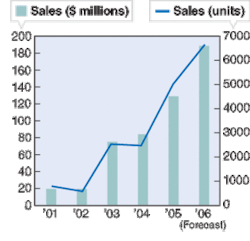CONFERENCE REVIEW: Photonics goes high profile at Photonics West '06

Judging by the number of new products introduced at Photonics West (San Jose, CA; Jan. 21-26) that addressed needs such as health care, communications, industrial efficiency, and security, Ken Kaufmann of Hamamatsu (Bridgewater, NJ) was on the mark when he noted in the Executive Panel: Market Direction and Implications for the World of Photonics that photonics technologies will solve problems and make our lives better.
Kaufmann was not alone in his observations. Paul Meissner, vice president of Global Business Operations for Coherent (Santa Clara, CA), noted in his Executive Panel presentation that the photonics industry could grow beyond its perceived boundaries if it increased the adoption of photonics in consumer-driven markets. Similarly, Giorgio Anania, president and CEO of Bookham (San Jose, CA), said that photonics companies must look beyond the communications industry to industries with a healthy market size and longevity. “We don’t want a bigger slice of the pie-we want a bigger pie,” Meissner said.
These sentiments were echoed by the upbeat feeling on the Photonics West show floor, with more than 1000 exhibitors this year (up from 876 in 2005) and 16,500 attendees-both new records, according to conference organizer SPIE.
The latest goods
On the exhibit floor, Corelase (Tampere, Finland) announced its new 20-W, 5-µJ ultrashort-pulsed fiber laser, X-LASE, for material processing applications. Cobolt (Stockholm, Sweden) showcased its Cobolt Jive laser, a 561‑mm, 50-mW diode-pumped solid-state laser for applications based on laser-induced fluorescence. SensL introduced its so-called Silicon Photomultiplier, which actually is a parallel-connected array of photon-counting pixels acting as a large-area, high-gain (106) avalanche photodiode that behaves like a traditional photomultiplier tube, in addition to having photon-counting ability. The device produces a proportional output at low photon counts, has a 20% quantum efficiency, is small and rugged, and is not damaged by ambient light.
A working model of an illumination-delivery system, expected to be available in the second quarter of 2006, was shown by Edmund Optics (Barrington, NJ) at its booth. The company says the device captures LED and OLED light so that it can be channeled through an aperture at an efficiency that reaches the limits of what physics allows. Chris Cummings, an R&D engineer at Edmund, claimed that the LED light output from EOS will be at least two to five times brighter than that captured conventionally from quartz-halogen bulbs.
Biomedical applications continue to drive product development as well. “Mini” appears to be a growing trend in spectrometers, such as the new Multimodal Multiplex Spectroscopy (MMS) systems from Centice (Durham, NC): the MMS Raman (marketed by Ocean Optics; Dunedin, FL) and MMS UV/Vis (marketed by Newport; Irvine, CA). The push to make smaller, less-expensive spectroscopy instruments for a variety of applications is also resulting in industry partnerships; Mesophotonics (Southampton, England) announced a joint marketing agreement with Horiba Jobin Yvon that combines Horiba’s Raman spectroscopy systems and Mesophotonics’ surface-enhanced Raman spectroscopy substrate called Klarite to enable faster, higher-accuracy analysis of biological and chemical samples at lower detection limits.
A laser nerve stimulator exhibited by Aculight (Bothell, WA) uses localized pulsed light in the 1.85- to 1.88-mm range passing through the skin to trigger nerves-potentially useful as a therapeutic or diagnostic tool. Light with pulse durations from 10 µs to 10 ms is directed through an optical fiber to the skin, where it passes through to stimulate the nerve.
Fiber lasers heat up
Outside of the exhibit hall, a host of market- and business-oriented sessions covered everything from nanotechnology to low-cost manufacturing, commoditization, and, of course, China. At the Fiber Laser Markets Forum (sponsored by Laser Focus World), representatives from Aculight (Bothell, WA), Nufern (East Granby, CT), SPI Lasers (Southampton, England), IPG Photonics (Oxford, MA), and NP Photonics (Tucson, AZ) noted that the success of fiber lasers is due to the manufacturing infrastructure and technology advances enabled by the telecommunications boom period. Andy Held of Nufern emphasized that fiber lasers can be manufactured using the same assembly-line processes used for telecom components, while Bill Shiner of IPG noted that while half of the 18,000 units IPG shipped last year were fiber lasers, the other half were amplifiers for telecommunications applications.
The highly competitive atmosphere surrounding the commercial introduction of fiber lasers was quite evident during the panel discussion Q&A, when an audience member asked who will stop vertically integrated IPG Photonics from effectively capturing the entire fiber-laser market. The dominant message was that the current $123 million fiber-laser market has the potential to grow to a $2.3 billion market and beyond-big enough for everyone to get a hefty slice of the pie.
About the Author
John Wallace
Senior Technical Editor (1998-2022)
John Wallace was with Laser Focus World for nearly 25 years, retiring in late June 2022. He obtained a bachelor's degree in mechanical engineering and physics at Rutgers University and a master's in optical engineering at the University of Rochester. Before becoming an editor, John worked as an engineer at RCA, Exxon, Eastman Kodak, and GCA Corporation.
Kathy Kincade
Contributing Editor
Kathy Kincade is the founding editor of BioOptics World and a veteran reporter on optical technologies for biomedicine. She also served as the editor-in-chief of DrBicuspid.com, a web portal for dental professionals.

Gail Overton
Senior Editor (2004-2020)
Gail has more than 30 years of engineering, marketing, product management, and editorial experience in the photonics and optical communications industry. Before joining the staff at Laser Focus World in 2004, she held many product management and product marketing roles in the fiber-optics industry, most notably at Hughes (El Segundo, CA), GTE Labs (Waltham, MA), Corning (Corning, NY), Photon Kinetics (Beaverton, OR), and Newport Corporation (Irvine, CA). During her marketing career, Gail published articles in WDM Solutions and Sensors magazine and traveled internationally to conduct product and sales training. Gail received her BS degree in physics, with an emphasis in optics, from San Diego State University in San Diego, CA in May 1986.
